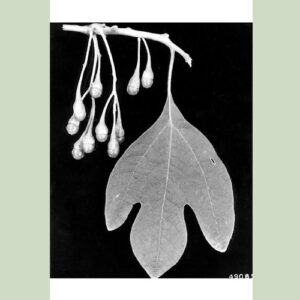Showing the single result
Sassafras (Sassafras Albidum)
Cold Stream Farm is the proud purveyor of wholesale Sassafras from our land and headquarters in Free Soil, Michigan. Our live sassafras plants are typically only available in the spring, with wholesale and retail shipments for customers throughout the United States. Please contact Cold Stream Farm if you have any questions about the current or future availability of retail and wholesale Sassafras plants.
What is a Sassafras?
We grow, maintain, and sell live Sassafras (Sassafras albidum) plants, which are native to most of the eastern states in the US. Wild sassafras plants can be found from Texas all the way to Maine, with some growth as far north as Ontario and as far south as Florida. Sassafras albidum belongs to the Sassafras genus, which contains 2 other Sassafras plants that are native to China and Taiwan.
Size and Appearance
A mature North American sassafras plant will grow to be between 30 and 60 feet depending on soil, sunlight, and weather conditions. Canopies are typically flat, with branches extending up and out for a maximum spread of nearly 40 feet. The roots of a sassafras tree are very thick and fleshy, quickly growing downwards from a large, central, and dominant taproot.
The Colors of a Sassafras Tree
A sassafras tree produces yellow-green flowers each spring, with the flowers of female plants becoming bluish-black berries that mature in the fall. On young trees, sassafras bark is brownish-orange, which develops into a darker, reddish-brown color as it becomes more rigid.
Sassafras leaves are green (or yellowish-green in some cases) throughout the year before turning into a variety of red-tinged yellow shades in the fall.
Ideal Sassafras Growing Conditions
Sassafras trees grow well in nearly any moist and loose soil condition. Compared to other species, sassafras trees may struggle to get established, with attention and care required throughout the plant’s early stages. We recommend planting sassafras in the early spring within USDA hardiness zones 4-9.
Ideally, a sassafras tree is planted in well-drained, rich sandy loam soil with a pH between 6 and 7. Although a sassafras seedling can tolerate partial shade conditions, both saplings and mature trees grow and thrive best in full sunlight conditions.
How to Plant and Maintain Sassafras albidum
Once a sassafras plant begins to grow, its roots will expand rapidly, often producing root sprouts that grow into neighboring trees. This causes unmaintained sassafras plants to mature in very dense thickets, with clones quickly producing around a large, central trunk. To keep from spreading, ornamental plants should be monitored for root suckers.
Sassafras plants have a high tolerance for drought, so well-drained soil is critical to their success. Regular watering is necessary until the plants reach over one foot in height. Transplanted sassafras plants should be placed in holes dug to be slightly larger than the pot it was previously held in, with a layer of mulch added to limit the amount of potential water loss.
Human Uses for Sassafras albidum
Sassafras plants have a long-standing connection with the human race, dating back before the European settlement of North America. Native American tribes throughout the modern eastern United States used many parts of the sassafras plants for a variety of purposes.
Primarily, parts of the sassafras plant have been used medically to treat wounds, fevers, acne, and more. Bark and other plant parts have also been used to both create dyes and cure meats. The wood from a sassafras plant is also a great fire starter thanks to its highly flammable natural oils.
Ecology and Wildlife Interaction
Sassafras plants are often visited by deer, birds, and other wildlife species. The branches, leaves, and seeds are edible and frequently grazed by many of the animals that the trees attract.
Sassafras albidum trees are often crawling with caterpillars and silkmoths, who call the plant home. Unfortunately, sassafras trees also attract redbay ambrosia beetles, which can cause laurel wilt among many of the other diseases that sassafras trees are prone to.
Sassafras in Modern Culture
In drug culture, Sassafras is a street name for methylenedioxyamphetamine, also known as MDA, sally, or simply “sass.” The stimulant and hallucinogenic substance originates from sassafras oil and is banned by the U.S. Food and Drug Administration as a Schedule 1 Drug.
Thanks to its widespread population throughout the eastern United States, there are many restaurants, kitchens, and eateries named after the sassafras plant that primarily offer Creole cuisine. The bark of a Sassafras tree is also still widely used to create teas, root beers, and other beverages.
Purchase wholesale sassafras plants from Cold Stream Farm.
Please check our current availability of sassafras plants to get started with your order instantly. We sell wholesale and retail sassafras plants with no minimum order required for shipping throughout the United States. If you have any questions about your order or future availability of live sassafras plants, please don’t hesitate to reach out to a member of the Cold Stream Farm team during ordinary business hours.


